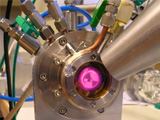|
|
TODAY.AZ / Weird / Interesting
Super-powerful X-ray beam will probe the center of the earth
11 November 2011 [14:00] - TODAY.AZ
 It is much easier to get to Mars than to get deep inside this planet, so for all our knowledge about things like earthquakes and the magnetic field, Earth’s interior is actually very poorly understood. To study how metals interact at the prodigious pressures within, scientists squeeze small particles in the lab and heat them up — but this is an inexact science and difficult to do. A newly revamped X-ray beam facility in Europe may be able to improve matters, and shed some light on just what is going on at the center of our planet.
It is much easier to get to Mars than to get deep inside this planet, so for all our knowledge about things like earthquakes and the magnetic field, Earth’s interior is actually very poorly understood. To study how metals interact at the prodigious pressures within, scientists squeeze small particles in the lab and heat them up — but this is an inexact science and difficult to do. A newly revamped X-ray beam facility in Europe may be able to improve matters, and shed some light on just what is going on at the center of our planet.The European Synchrotron Radiation Facility inaugurates its new ID24 beam today, in preparation for experiments next spring. It will enable scientists to exact extreme pressures and temperatures on metals, aiming to understand how they act at Earth’s core. It will also be able to study new chemical catalysts and battery technology, among other atomic reactions.
A synchrotron is a type of particle accelerator — the Tevatron is one — that can be used for a wide range of applications. One such application involves harnessing the accelerated particles' electromagnetic radiation for scientific imaging. Synchrotron light sources use a series of magnetic fields to bend this radiation into different wavelengths of light. At ESRF, beamlines branch off from the particle acceleration ring to capture the particles’ (usually electrons) radiation. The new beamline, ID24, will enable incredibly fast X-ray absorption spectroscopy.
This works by firing an intense X-ray beam at a sample, and watching how atoms of the different elements inside the sample absorb the X-rays — it’s an active probe, monitoring its own experiments. The beamline has an array of germanium detectors that can take 1 million measurements per second, according to an ESRF news release. So scientists could take a small sample of iron, put it in the beamline, heat it to 10,000 degrees, and watch what happens. This would conceivably help scientists understand how iron behaves 1,500 miles beneath the surface of the Earth, and what are the melting points of other metals present in the mantle and core. This, in turn, could shed some light on things like Earth’s dynamo, which creates its magnetic field.
The ID24 beam is the first of eight new beamlines at ESRF, part of a $245 million (180 million Euro) upgrade.
/Popular Science/
URL: http://www.today.az/news/interesting/97983.html
 Print version
Print version
Views: 1692
Connect with us. Get latest news and updates.
See Also
- 05 February 2025 [19:41]
Japan plans to negotiate with Trump to increase LNG imports from United States - 23 January 2025 [23:20]
Dubai once again named cleanest city in the world - 06 December 2024 [22:20]
Are scented candles harmful to health? - 23 November 2024 [14:11]
Magnitude 4.5 earthquake hits Azerbaijan's Lachin - 20 November 2024 [23:30]
Launch vehicle with prototype of Starship made its sixth test flight - 27 October 2024 [09:00]
Fuel prices expected to rise in Sweden - 24 October 2024 [19:14]
Turkiye strikes terror targets in Iraq and Syria - 23 October 2024 [23:46]
Kazakhstan supplied almost entire volume of oil planned for 2024 to Germany in 9 months - 23 October 2024 [22:17]
Taiwan reported passage of Chinese Navy aircraft carrier near island - 23 October 2024 [21:50]
Russia remains largest oil supplier to India
Most Popular
 Pashinyan signed up for a ChatGPT course
Pashinyan signed up for a ChatGPT course
 Mono-Armenia what tales did Pashinyan tell in Washington
Mono-Armenia what tales did Pashinyan tell in Washington
 Turkiye’s President Erdo?an approves migration cooperation agreement with Azerbaijan
Turkiye’s President Erdo?an approves migration cooperation agreement with Azerbaijan
 Ruins of an Azerbaijani mosque are being desecrated in Yerevan
Ruins of an Azerbaijani mosque are being desecrated in Yerevan
 Azerbaijan bans entry of Russian MP over offensive remarks
Azerbaijan bans entry of Russian MP over offensive remarks
 Armenians are preparing for a "crusade" against Baku – hopes for the United States
Armenians are preparing for a "crusade" against Baku – hopes for the United States
 Azerbaijan’s fire safety service reviews 2024 successes and prepares for 2025
Azerbaijan’s fire safety service reviews 2024 successes and prepares for 2025
